The arrival of the updated Mercedes-Benz V-Class caps off a big 12 months or so for people movers in Australia.
-
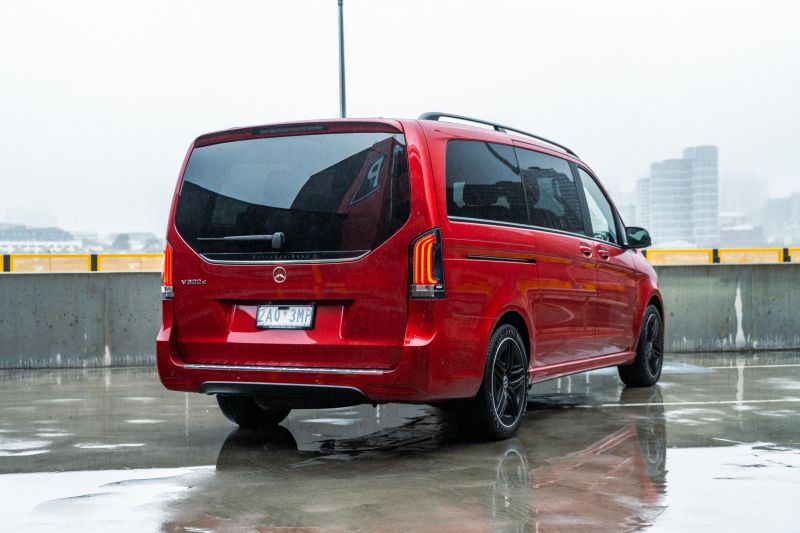
V300 AMG
In 2023, we welcomed the electric LDV MIFA 9 and luxurious Lexus LM. While hybrid versions of the Kia Carnival launched last year. More recently, China’s challenger Zeekr opened orders for its powerhouse 009, and the Ford Transit Custom-based Tourneo went on sale locally.
And if that wasn’t enough, the new T7 Volkswagen Multivan will join the crowd in the second quarter of this year, providing a cheaper European alternative to the hauler on test here.
The new generation of people movers is a mix of fresh and familiar. On one hand, few will have experienced a silent electric MPV capable of sprinting from 0-100km/h in 4.5 seconds. On the other, the upcoming VW Multivan builds on an existing formula, retaining turbo-diesel power and a timeless exterior design.
So, where does this facelifted V-Class sit? It’s on the side of evolution, rather than revolution.
Under the bonnet, you’ll find a carryover turbo-diesel powertrain, and inside there are precious few futuristic gizmos. Changes include refreshed exterior styling and a significant interior update, bringing the V-Class up to date with the rest of the Mercedes-Benz model range.
Is that enough for it to remain competitive in 2025? Let’s find out.
Here we’re focusing on the two V300 variants, the AMG and Exclusive.
How does the Mercedes-Benz V-Class compare?
View a detailed breakdown of the Mercedes-Benz V-Class against similarly sized vehicles.

Mercedes-Benz
V
How much does the Mercedes-Benz V-Class cost?
Pricing starts at $114,449 before on-roads for the V250 Avantgarde, and extends to $143,809 before on-roads for the V300 Exclusive.
-

V300 Exclusive
| Model | Price before on-road costs |
|---|---|
| 2025 Mercedes-Benz V250 Avantgarde | $114,449 |
| 2025 Mercedes-Benz V300 AMG | $140,543 |
| 2025 Mercedes-Benz V300 Exclusive | $143,809 |
To see how the Mercedes-Benz V-Class stacks up against the competition, check out our comparison tool.
What is the Mercedes-Benz V-Class like on the inside?
Sitting up front in a people mover is often considered a booby prize, but the driver’s seat of the new V-Class is nevertheless a pleasant place to spend your time.
-
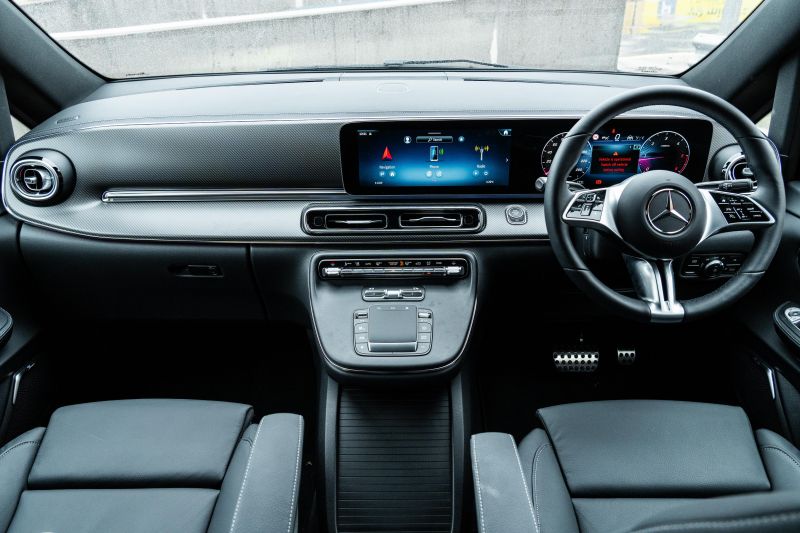
V300 AMG
Whether you opt for the AMG or Exclusive trim grade, V300 models are brimming with soft-touch cabin materials from supple leather on the steering wheel and armrests to textured plastics on the door cards and dash.
The AMG brand is synonymous with sophisticated performance, and there are hints of that throughout our tester – carbon-look dash trim, for one, while the air vents present like scale models of a jet engine.
Customisable ambient lighting elevates the cabin further, distracting occupants from harder, scratchier plastics that coat the lower panels.
The seating arrangement is as you’d expect in a big, premium van. Both front seats are trimmed in lovely black leather, with electric adjustment, three-stage heating, and lumbar support.
Flagship Exclusive examples gain Nappa leather, although the standard ‘Lugano’ type is bound to impress most.
This all sounds great on paper, but the reality is a little less clear cut. While the seats are well-equipped, there’s not much side bolstering which is important in vans that have a tendency to roll through corners.
In addition, the sculpting of the backrest creates an annoying gap at the base of the seat, which left my lower back unsupported. It’s an issue that can’t be remedied by lumbar adjustment, and the V-Class was uncomfortable over longer journeys as a result.
The lack of a dead pedal for the driver doesn’t help the situation. Instead, you’re expected to rest your left foot somewhere on the open section of floor next to the pedals.
On a positive note, both the driver and passenger and provided with a soft leather armrest, and the driver’s headrest is power-adjustable.
All considered, it’s tough to say that the new V-Class is more comfortable than its predecessor. However, it does deviate significantly in the technology department.
Significant updates have brought the technology suite up to date with the rest of the Mercedes-Benz model range.
A pair of 12.3-inch digital displays now protrude from the dash, both incorporated into a single sweeping housing.
The centre infotainment display makes an excellent first impression, with crisp graphics and a user-friendly app grid layout annotated by a classy combination of text and image labels.
Touch inputs are met with quick processing times, and the screen can also be operated via a separate touchpad or haptic steering wheel controls.
Apple CarPlay and Android Auto are the default choice of interface for many new car buyers, and Mercedes-Benz offers seamless wireless smartphone mirroring, but the native infotainment system makes for an excellent alternative.
The native navigation offering is slick and detailed, while the array of Mercedes-Benz apps includes an internet browser. Even when using CarPlay, the home shortcut icon remains at the top right of the screen, enabling quick transitions between the two technologies.
Dual USB-C outlets are located below the centre stack, as well as a 12V socket and wireless charging pad.
Audio quality from the Burmeister surround sound system is exceptional, with ample capacity for customisation. A few tweaks to the sound dynamics can transform the atmosphere in the V-Class, whether you’re chasing the bass of a heaving nightclub or the clarity of a quiet auditorium.
Leaving the fresh tech to one side, storage space up front is limited. While not a priority in a vehicle with such supreme all-round practicality, I was left wanting by the lack of cubbies to store life’s odds and ends. For example, there’s no real centre console, and the glovebox is just average.
Large drink bottles fit perfectly in the wide door bins, and sunglasses can be stored overhead.
-
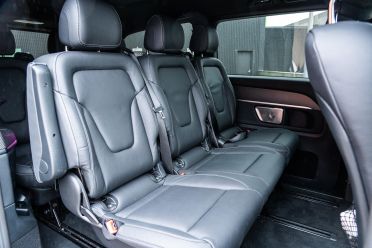
V300 AMG -
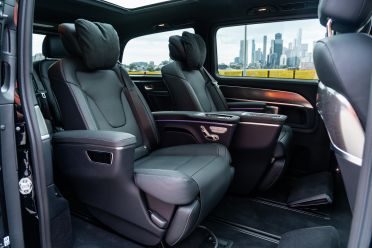
V300 Exclusive
Despite the long list of equipment found up front, the second row is where you want to be. That’s true for the AMG variant, but even more so for the bougie Exclusive with the luxury seats package.
For the measly price of $17,895, buyers can opt to remove the regular second-row seats and replace them with heated, cooled, massaging and fully-reclinable second-row captain’s chairs. That’s not to mention the inclusion of a folding table, cupholders, USB-C ports and a dedicated smartphone tray – perfect for a travelling CEO.
Many people movers promise comfortable transport, but few can match the luxury of a V-Class in this specification.
However, most of our time was spent with the AMG, which sits a little lower on the wow factor scale.
Ingress is easy regardless of variant, as all have electric sliding rear doors with several methods of opening. Egress is equally straightforward, with touch buttons for exit located on the inside of each B-pillar.
The trio of adjoined leather seats in the second row of our tester all offer a decent amount of legroom, and they slide forward and back on manually-operated rails.
Like the front seats, the second row is trimmed in supple, textured leather that offers excellent comfort. Each outboard seat pairs with a fold-down armrest for added comfort.
All three chairs are reclinable, ensuring that headroom is never an issue, even though there’s plenty when seated upright. It’s an open and airy place to sit, too – the windows don’t open, but an expansive panoramic roof bathes the cabin in light.
If I had one complaint about the second row seating arrangement, it’s a lack of toe room that makes it tricky to properly spread out.
And amenities are hard to come by. USB outlets are nowhere to be seen, nor are there any central cupholders. A
It’s a spartan space, so much so that the luxury seat package is a must for buyers who intend to ferry around VIP passengers.
After all, rockstars and sporting legends are unlikely to be impressed by a couple of reading lights and a single climate control panel.
The second row of the V-Class doesn’t offer much from a storage perspective, either, with skinny door bins and a pair of cargo nets.
Such is the state of the second row in the AMG that you’re almost better off skipping it in favour of the ‘back-back’.
Third row passengers are treated to removeable cupholders, 12V power outlets and side storage bins, while there’s also more toe room here than in the second row.
Again, the leather seats are soft and inviting, although you don’t have access to armrests or any recline functionality.
Even with all eight seats occupied, boot space remains impressive. The power tailgate opens nice and high, so high in fact that you have to be careful in carparks with a low ceiling.
Once you’ve crossed that hurdle, you’re greeted by a deep, flat, and square space. That makes it easy to play Tetris with luggage, as I found out when loading my colossal cricket bag into the cargo area.
Mercedes-Benz quotes 1030 litres of capacity with all three rows of seating in place – significantly more than rivals including the Kia Carnival (627L), Zeekr 009 (574L), and Lexus LM (110L).
In its default state, the boot is split into two horizontal tiers which maximise the space. The top shelf can be configured to offer either a flat bench or two carved out storage trays, hidden under a lid. Rear practicality is bolstered by the inclusion of a 12V power source.
As previously mentioned, each row is set up to both fold and slide, depending on whether you prioritise luggage space or seating capacity.
| 2025 Mercedes-Benz V-Class | |
|---|---|
| Length | 5140mm |
| Width (excluding mirrors) | 1928mm |
| Height | 1880mm |
| Wheelbase | 3200mm |
| Boot space (rear seats up) | 1030L |
| Boot space (rear seats folded) | 4630L |
| Gross vehicle mass | 3200kg |
| Gross combination mass | 5700kg |
To see how the Mercedes-Benz V-Class stacks up against the competition, check out our comparison tool.
What’s under the bonnet?
All V-Class models are powered by a 2.0-litre turbo-diesel four-cylinder engine, mated to a nine-speed automatic transmission and rear-wheel drive.
The engine is offered in two different states of tune – base V250 examples produce 140kW of power and 440Nm of torque, while the V300 is boosted up to 174kW and 500Nm.
| Specifications | Mercedes-Benz V300 |
|---|---|
| Engine | 2.0-litre 4cyl turbo-diesel |
| Power | 174kW |
| Torque | 500Nm |
| Transmission | 9-speed automatic |
| Drive type | Rear-wheel drive |
| Weight (tare) | 2441kg |
| Fuel economy (claimed) | 6.9L/100km |
| Fuel economy (as tested) | 11.9L/100km |
| Fuel tank capacity | 70L |
| Fuel requirement | Diesel |
| CO2 emissions | 181g/km |
| Emissions standard | Euro 6 |
| Braked tow capacity | 2500kg |
To see how the Mercedes-Benz V-Class stacks up against the competition, check out our comparison tool
How does the Mercedes-Benz V-Class drive?
The V-Class is about as refined as a diesel people mover can get, but electrification has moved the game on beyond the capabilities of old-school oil burners.
-
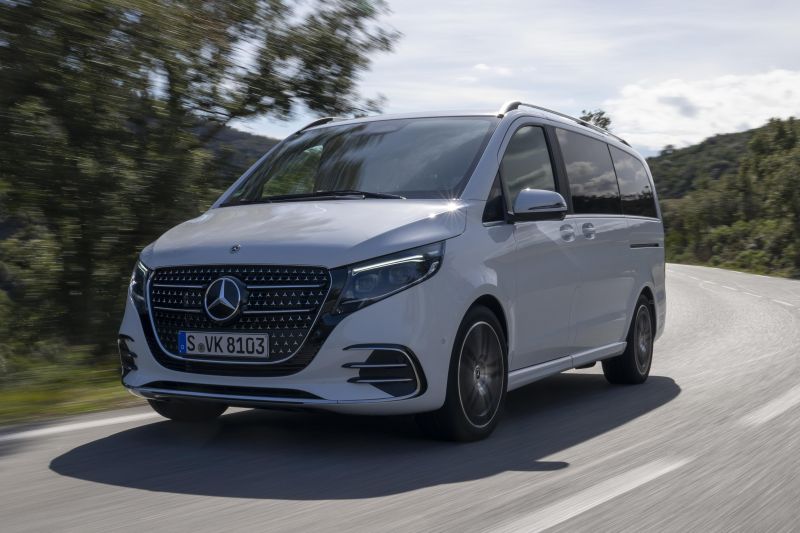
Overseas models shown
A familiar mechanical clatter is present on startup, and it never really leaves despite the efforts of Mercedes-Benz to insulate the cabin from unwanted noise.
The updated V-Class is far from loud in town, but new electric people movers offer complete silence and the hybrid Kia Carnival isn’t far off.
This vehicle will likely be bought by private drivers tasked with ferrying around VIP passengers, and what those passengers want is peace and quiet. If this were a cheaper, mass market MPV, I’d place less emphasis on this point.
While passengers may be better served spending time in a rival people mover, the V-Class has plenty to offer the driver.
The steerer sits high and upright with a commanding view of the road. It’s a little less car-like than the outgoing VW Multivan, but visibility is great both out the front of the vehicle and either side courtesy of chunky side mirrors. V300 variants feature a digital rear-view mirror, providing an unimpeded view regardless of who’s in the back.
In V300 guise, the 2.0-litre turbo-diesel punches above its weight, providing plenty of hauling power right through the rev range. You’re never left wanting when taking off from a standstill, and throttle inputs are met with immediate response from the engine.
It’s paired with a razor sharp nine-speed automatic transmission that hunts for the highest gear possible, which both keeps you in the torque band and limits engine noise as much as possible.
The steering is light and changes in direction are snappy, although there’s not much feel through the wheel. People movers are tricky to pilot at the best of times, so that feeling of disconnection can be quite disconcerting.
And the 5.1m length of the V-Class is apparent in urban situations – uninitiated drivers will find it easy to lose track of the rear of the van, which can result in clipped curbs and cut corners.
Inner city driving is particularly challenging, requiring equal measures of care and concentration. The same is true of all people movers, though.
Difficulties in driving the V-Class are compounded by its questionable stopping power. The 300mm front and rear disc brakes feel undercooked, with no pedal feel and longer than expected stopping distances.
Not only is that an issue in stop/start traffic, but it detracts from the otherwise competent semi-autonomous driving system on the highway.
-
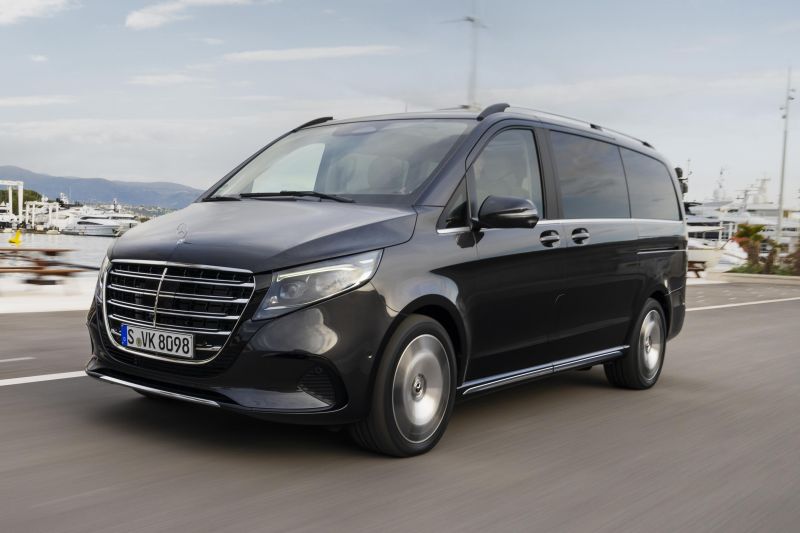
Exclusive
Mercedes-Benz has done a better job with the suspension setup, which is truly plush even in the ‘sporty’ AMG model.
Bumps in the road are smoothed out without fuss, allowing rear passengers to read a book or catch up on sleep in comfort.
Somewhat surprisingly, the long square body of the V-Class is relatively easy to manage in parking situations. Reversing angles are easily calculated and the chunky mirrors help you to line things up. All versions of the V-Class come with a surround-view camera, and a rear-view camera with tailgate opening parameters marked on the infotainment screen.
On the highway the V300 remains a relatively refined thing, albeit with a couple of weaknesses. It’s got more than enough grunt to keep pace with surrounding traffic, and never feels stressed at triple figure speeds.
Tech upgrades for the facelift extend to the suite of safety systems, which includes adaptive cruise control with active steering assist.
The cruise functions are operated via haptic buttons and sliders on the steering wheel – usually not my favourite control type, but they work well in this application.
Adaptive cruise may be easy to use, but the system struggles to deal with stop/start traffic. The V-Class is slow to react to changes in the traffic flow, and it’ll often struggle to pull up behind a leading car without driver intervention.
If you’re caught placing too much trust in the tech the forward collision warning will activate, violently tightening the seatbelts.
The blind-spot warning function also gets a bit carried away, sensing danger when there isn’t any.
Aside from ADAS gripes, we were also a little disappointed by the volume of outside noise that seeps into the cabin, even in the absence of tyre roar.
Mercedes-Benz claims that the V300 will sip a respectable 6.9L/100km, but we saw 11.9L/100km over a week of mostly city driving. You won’t need to fill up very often – we covered 389km and didn’t even half empty the 70L fuel tank.
To see how the Mercedes-Benz V-Class stacks up against the competition, check out our comparison tool
What do you get?
Three variants of the Mercedes-Benz V- Class are available Down Under, plus an additional option pack for the top-spec Exclusive.
2025 Mercedes-Benz V250 Avantgarde equipment highlights:
- 19-inch alloy wheels
- Agility Control suspension
- Multibeam LED headlights
- Mercedes-Benz logo puddle lights
- Anodised roof rails
- Keyless start
- Eight seats
- Heated front seats with power adjustment, heating
- Lugano leather upholstery
- Dark grey open-pore olive wood-look dashboard
- Heated steering wheel
- Touch-sensitive steering wheel controls
- Sports pedals
- 12.3-inch digital instrument cluster
- 12.3-inch infotainment touchscreen
- Wireless Apple CarPlay and Android Auto
- Wireless smartphone charger
- Satellite navigation
- Burmester surround sound system
V300 AMG adds:
- Black 19-inch AMG wheels
- Panoramic sunroof
- AMG Night exterior styling package
- Sports suspension
- AMG rear bumper and spoiler lip
- Black roof rails
- Digital rearview mirror
- Carbon-fibre look dashboard
- Black headliner
- AMG floor mats
-
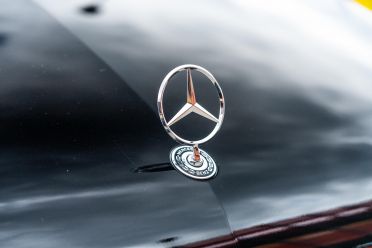
V 300 Exclusive -
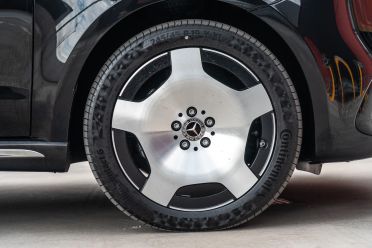
V300 Exclusive adds:
- Seven seats (second row now has only two seats)
- Rear tray tables with illuminated trim
- Five-louvre chrome grille
- LED light band
- Mercedes-Benz bonnet emblem
- Nappa leather upholstery
- Ventilated front seats
Only the V300 Exclusive can be ordered with the $17,895 Luxury Seats Package, which brings comfier second-row captain chairs seats with:
- Reclining
- Back massage
- Air-conditioning
- Footsteps
- Folding table
- Cup holders
- USB-C ports
- Integrated smartphone tray
To see how the Mercedes-Benz V-Class stacks up against the competition, check out our comparison tool
Is the Mercedes-Benz V-Class safe?
The Mercedes-Benz V-Class is unrated by ANCAP or Euro NCAP.
Standard safety equipment includes:
- Autonomous emergency braking
- Accident preparation system
- Active steering assist
- Adaptive cruise control with stop and go
- automatic high-beams
- Blind-spot monitoring
- Brake assist
- Driver attention monitoring
- Front, front-side and curtain airbags
- Front and rear parking sensors
- Lane keep assist
- Parking assist
- Rear cross-traffic alert
- Reversing camera
- Speed limiter
- Surround-view camera
- Traffic sign recognition
- Tyre pressure monitoring
To see how the Mercedes-Benz V-Class stacks up against the competition, check out our comparison tool
How much does the Mercedes-Benz V-Class cost to run?
The Mercedes-Benz V-Class is covered by a five-year, 250,000km warranty.
| Servicing and Warranty | Mercedes-Benz V-Class |
|---|---|
| Warranty | 5 years, 250,000km |
| Roadside assistance | 5 years |
| Service intervals | 12 months or 20,000km |
| Capped-price servicing | 3 years |
| Total capped-price service cost | $3141 |
To see how the Mercedes-Benz V-Class stacks up against the competition, check out our comparison tool
CarExpert’s Take on the Mercedes-Benz V-Class
The new Mercedes-Benz V300 AMG occupies an awkward position in the world of people movers, given recent advancements in the segment.
There’s no denying that it’s a far better vehicle than before – the fresh interior technology is slick and user-friendly, while revised exterior styling gives this luxury van far more road presence.
Prices have remained steady too, despite improvements to the package.
And even in the face of growing competition, the V-Class remains the class leader for practicality, with a massive boot that puts other people movers to shame.
However, the game really has moved on, and new rivals have better positioned their products. Private drivers for the rich and famous are arguably better served by the Zeekr 009, with its silent electric powertrain, opulent interior, and less crowded seating configuration.
The Lexus LM commands a higher price tag, but it’s also more special inside, even in base specification.
Now, the V300 ticks the luxury box in Exclusive specification with the optional seat package. And for that reason, it’s the pick of the range. Having said that, it’s a lot more expensive than the Zeekr, and on par with the Lexus.
At that price point, you can also get behind the wheel of an electric Mercedes-Benz EQV, which offers a quieter, more refined experience on the road.
So, the V300 AMG isn’t the pick of the luxury crop, but how does it fare against more utilitarian options?
Well, whichever way you cut it, the Kia Carnival is a better value proposition. A fully loaded Carnival GT-Line Hybrid will run you just over $83,000 drive-away, and it still features heated and cooled seats, a 12-speaker sound system, and an efficient hybrid powertrain.
Buyers set on a German diesel people mover have the upcoming Volkswagen T7 Multivan to look forward to. It’ll be priced similar to the Kia, and promises to bring marked improvements to refinement, ride and handling over the previous model.
Where does that leave the V-Class? It’s hard to say. The new Mercedes-Benz hauler doesn’t really make financial sense as a family school bus, but it isn’t a luxury leader at the top end, either.
For those reasons, I don’t expect the V300 to take the people mover market by storm.
Interested in buying a Mercedes-Benz V-Class? Get in touch with one of CarExpert’s trusted dealers here
Click the images for the full gallery
MORE: Everything Mercedes-Benz V-Class

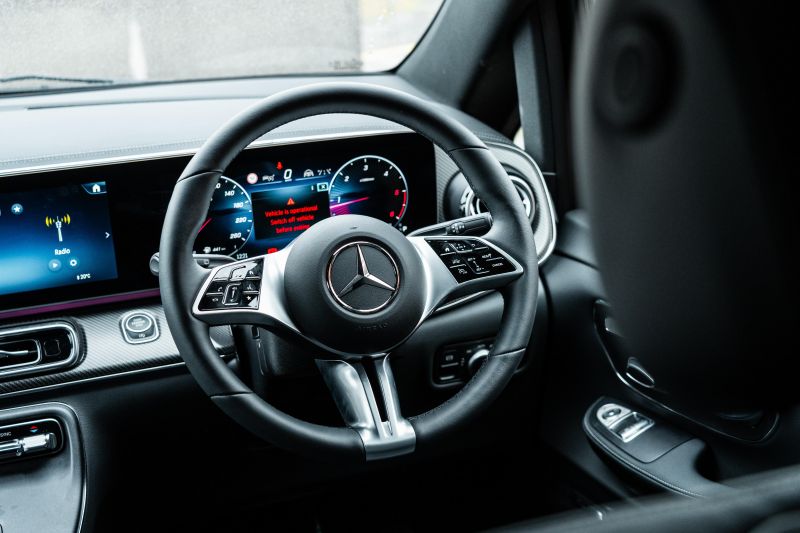
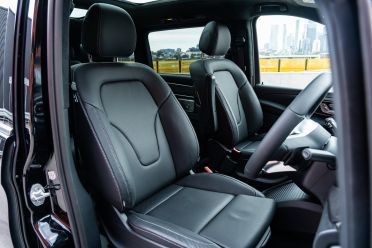
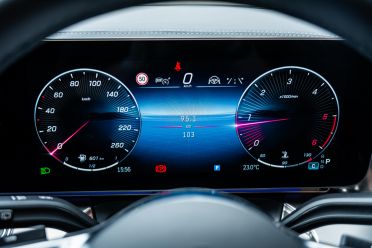
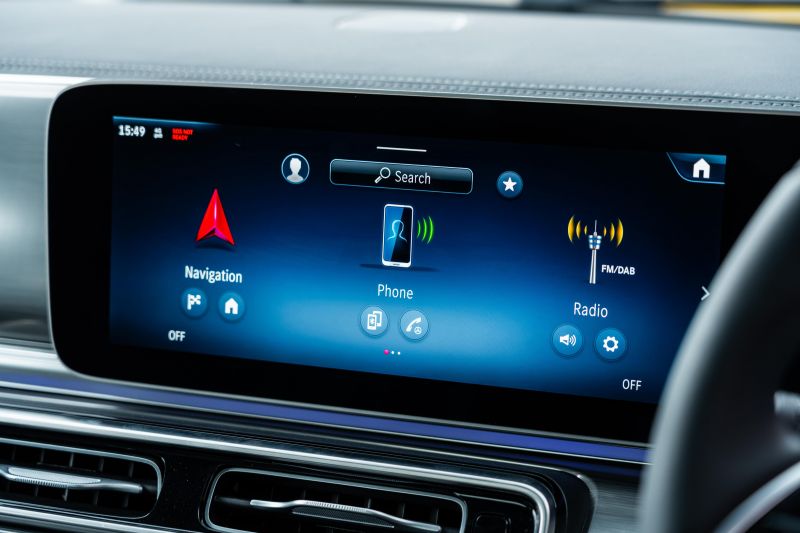
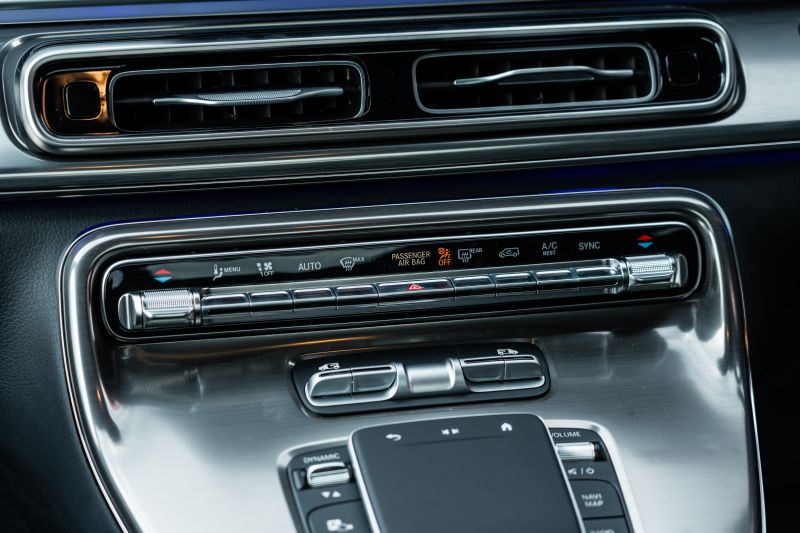
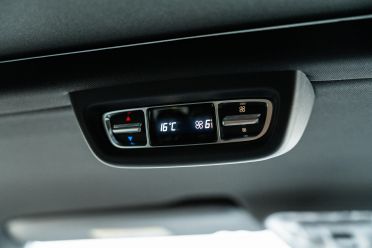
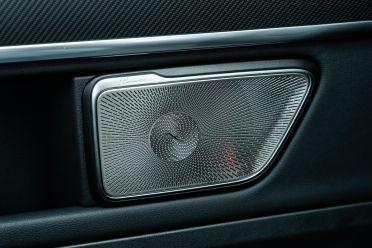
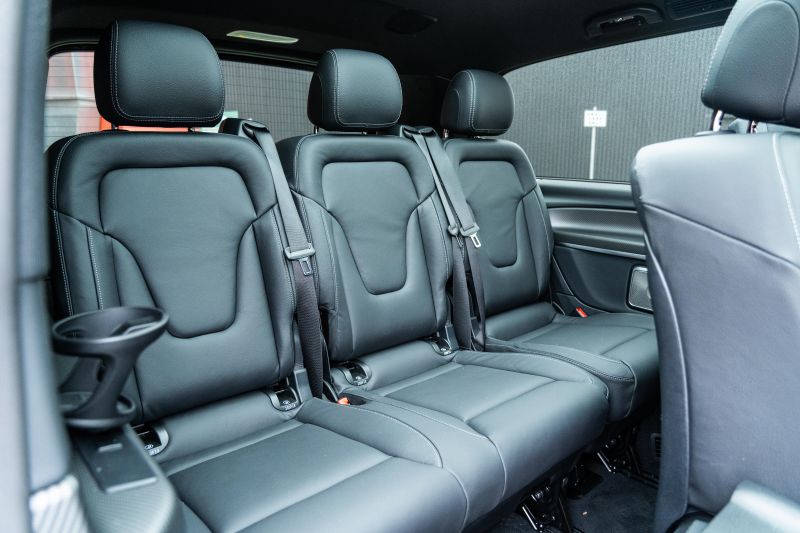
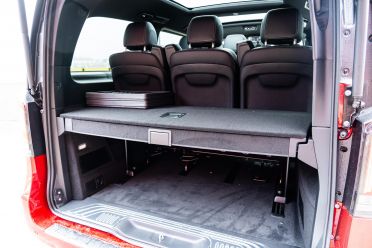
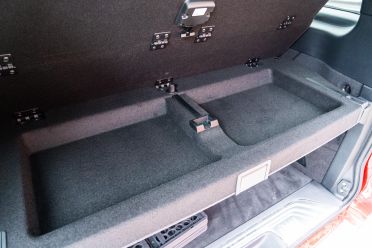
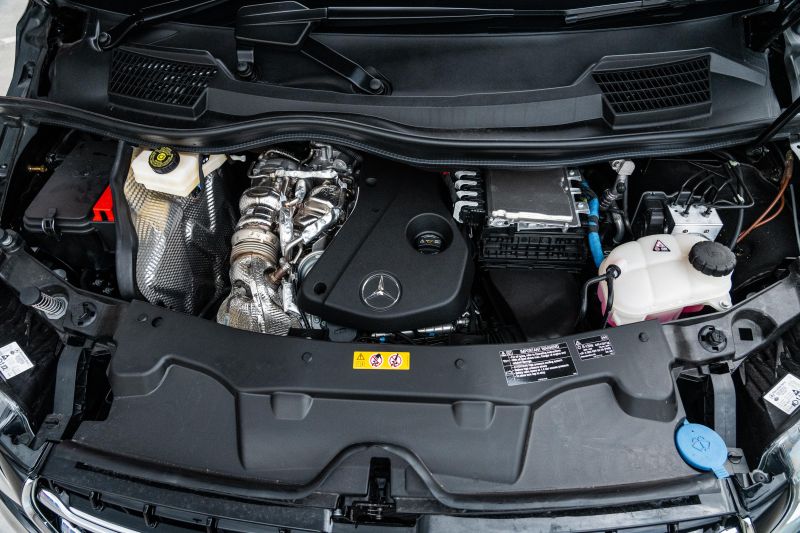
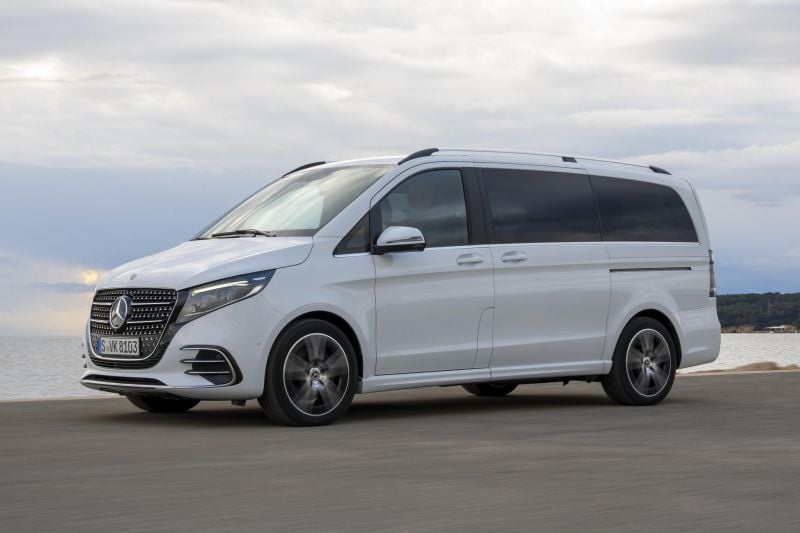
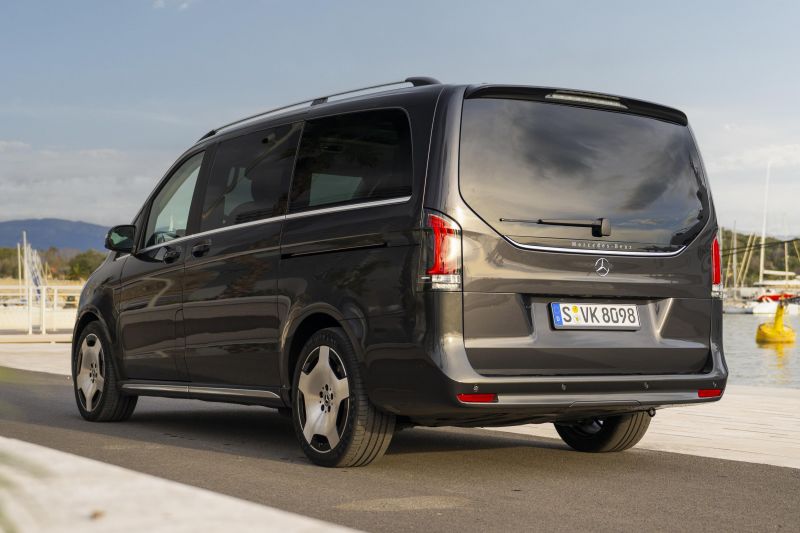
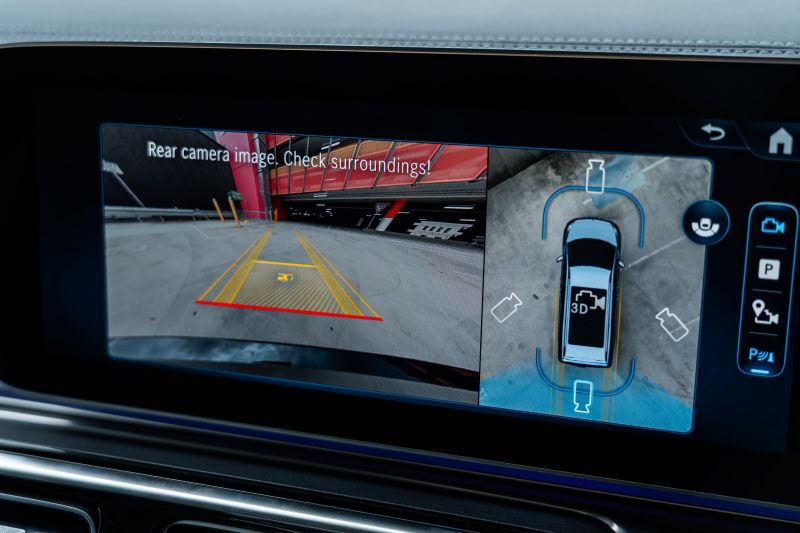

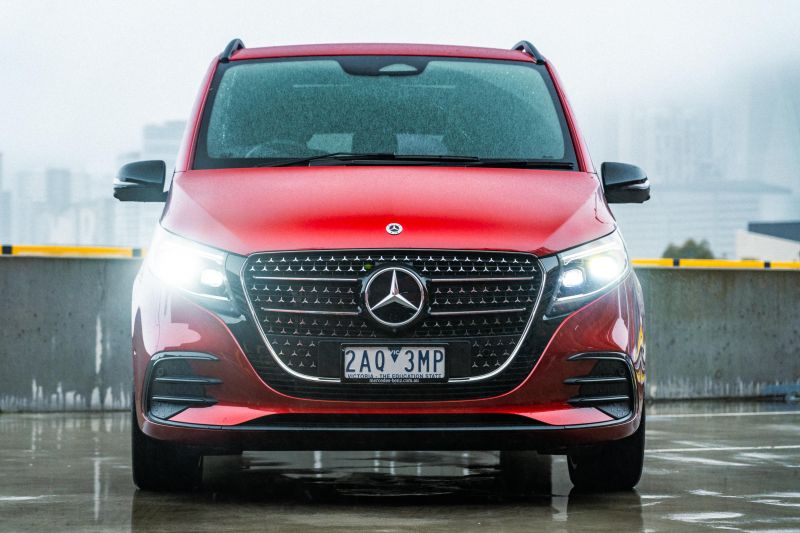
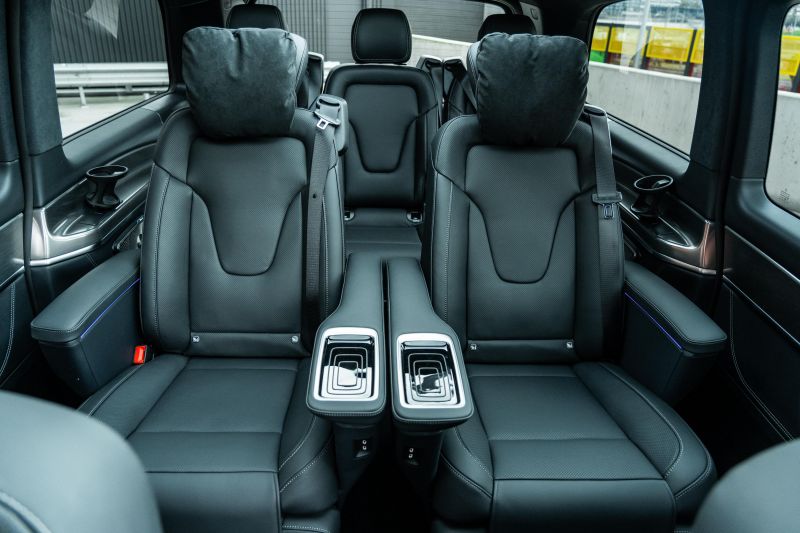
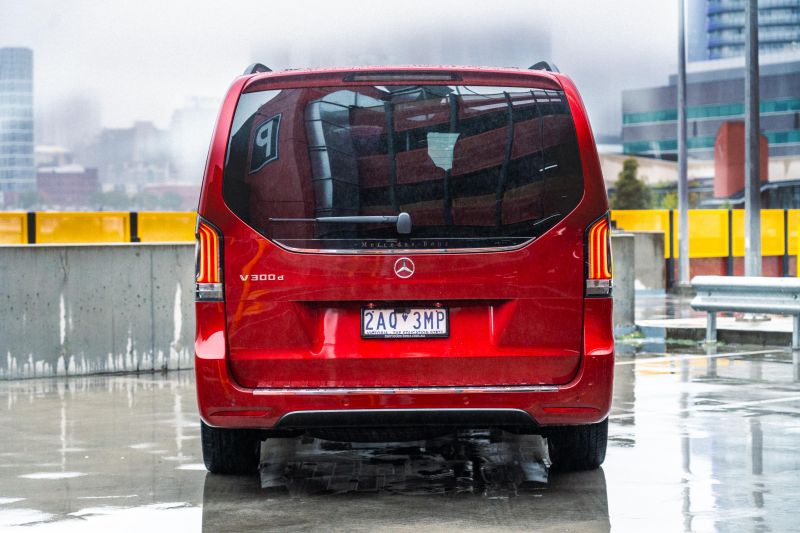










Leave a Reply